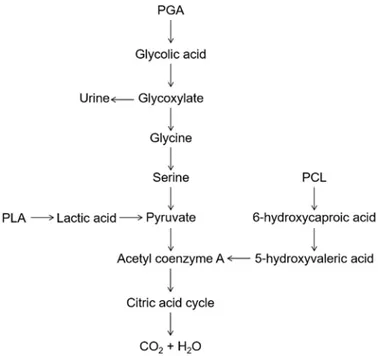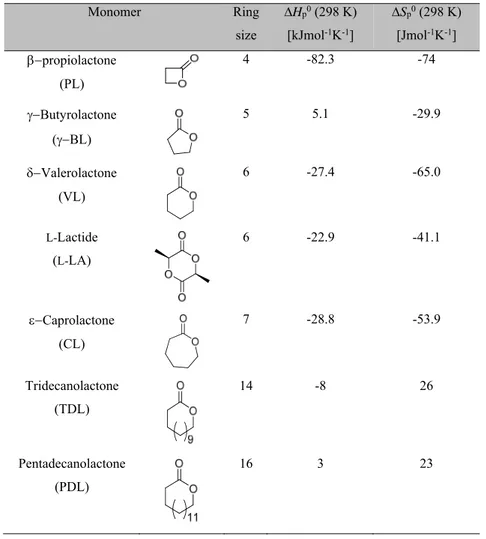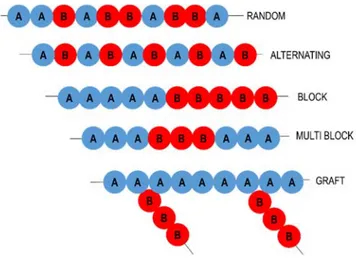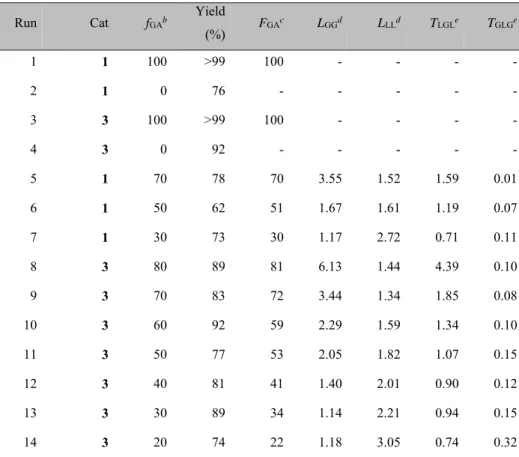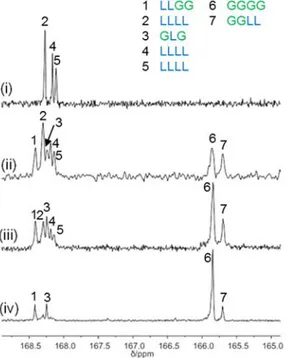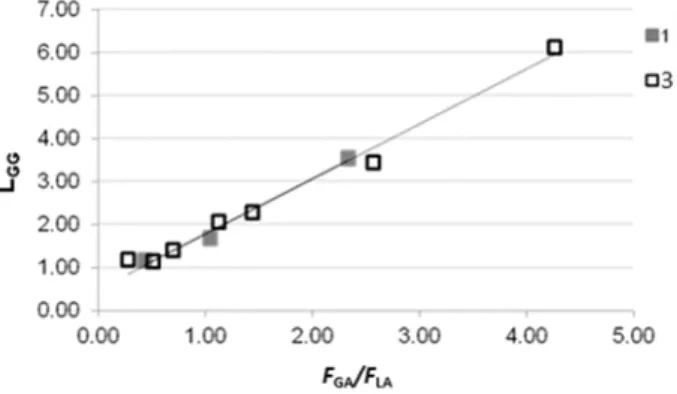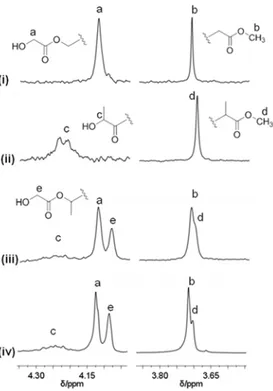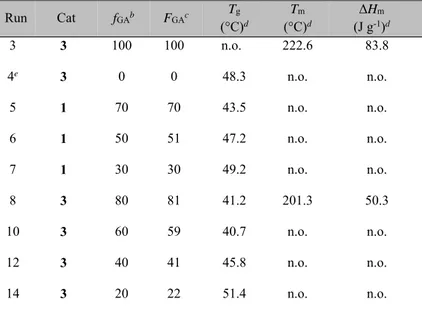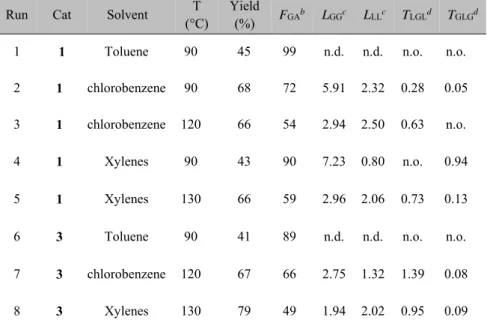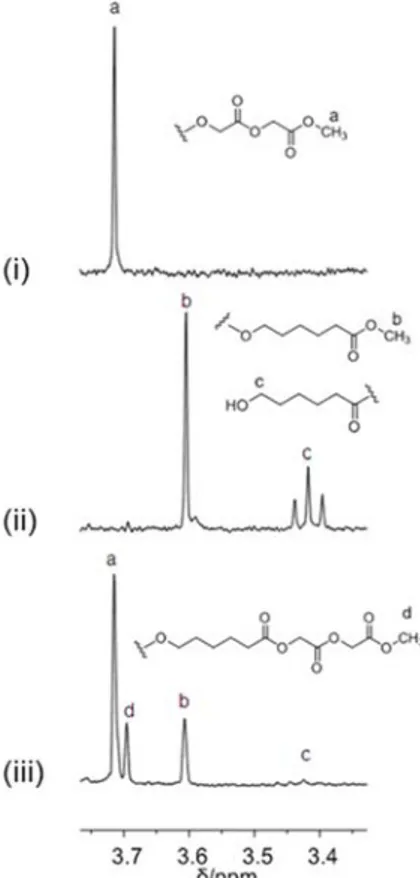D
IPARTIMENTO DI
C
HIMICA E
B
IOLOGIA
“A
DOLFO
Z
AMBELLI
”
D
OTTORATO DI
R
ICERCA IN
C
HIMICA
XIV
C
ICLO
(Nuova serie)
B
IODEGRADABLE AND
F
UNCTIONAL
A
LIPHATIC
C
O
-P
OLYESTERS
Tiziana Fuoco
T
UTORProf.
ssaDaniela Pappalardo
C
O-T
UTORSProf.
ssaMarina
Lamberti
Prof.
ssaAnna
Finne-Wistrand
C
OORDINATOREINDEX
ABSTRACT ... VI
LIST OF ABBREVIATIONS ... IX
1. INTRODUCTION ... 1
1.1. Aliphatic polyesters: generalities ... 1
1.2. Synthesis of aliphatic poly(ester)s: polycondensation versus ring-opening polymerization ... 3
1.2.1. Metal-based catalysts for the ROP of lactones and lactides .... 6
1.3. Properties and applications of the aliphatic polyesters object of this thesis ... 10
1.4. Copolyesters ... 13
1.5. Functional aliphatic polyesters by ROP ... 15
1.6. Polyesters polyethylene-like ... 17
AIMS OF THE THESIS ... 19
References ... 21
2.
RING-OPENING
COPOLYMERIZATION
OF
GLYCOLIDE, racLACTIDE AND
CAPROLACTONE .. 25
2.1. Introduction. ... 25
2.2. Results and Discussion ... 29
2.2.1. Catalysts synthesis ... 29
2.2.2. Homo- and copolymerization of rac-lactide and glycolide in bulk ... 30
2.2.2.1. End groups analysis by NMR of poly(rac-lactide-co-glycolide)s prepared in bulk. ... 36
2.2.2.2. Determination of molecular weight of poly(rac-lactide-co-glycolide)s prepared in bulk ... 39
2.2.2.3. Thermal characterization of
poly(glycolide-co-rac-lactide)s prepared in bulk. ... 41
2.2.3. Copolymerization of rac-lactide and glycolide in solution ... 43
2.2.4. Block copolymerization of rac-lactide and glycolide. ... 46
2.2.5. Copolymerization of glycolide and caprolactone. ... 49
2.2.5.1.Thermal characterization of poly( caprolactone-co-glycolide) ... 57
2.2.6. Terpolymerization of glycolide, rac-lactide and caprolactone. ... 59
2.2.6.1. Thermal characterization of terpolymers ... 66
CONCLUSIONS ... 68
References. ... 70
3. SYNTHESIS OF ALIPHATIC POLY(ESTER)S WITH
PENDANT THIOL GROUPS: FROM MONOMER DESIGN
TO EDITABLE POROUS SCAFFOLDS ... 74
3.1. Introduction ... 74
3.2. Results and discussion ... 78
3.2.1. Design and synthesis of the sulfur-functionalized monomer 78 3.2.2. Copolymerization ... 82
3.2.3. Polymer modifications ... 88
3.2.4. Scaffold preparation and characterization ... 91
3.2.5. Peptide binding on 3D porous scaffolds and cytotoxicity evaluation ... 94
CONCLUSIONS ... 99
References ... 101
4.
RING-OPENING
POLYMERIZATION
OF
SEMICRYSTALLINE AND FUNCTIONAL POLY(ESTER)S
... 106
4.1. Introduction ... 106
4.2. Results and discussion ... 109
4.2.1. Ring-opening polymerization of 6-hexadecenlactone ... 109
4.2.2. Functionalization of poly(6-hexadecenlactone) ... 117
4.2.2.1. Thermal and structural analysis of poly( 6-hexadecenlactone) and its functionalized dericatives .... 120
4.2.3. Copolymerization of 6-hexadecenlactone with small and medium size lactones ... 124
CONCLUSIONS ... 133
References ... 135
CONCLUDING REMARKS ... 140
5. EXPERIMENTAL SECTION ... 144
5.1. General experimental methods ... 144
5.1.1. Materials and methods ... 144
5.1.2. Instruments and measurements ... 145
5.2. Catalysts synthesis and characterization ... 147
5.2.1. Synthesis of {[2-O-C6H4]CH=NC6F5}Al(CH3)2 (1) ... 147
5.2.2. Synthesis of {[3-tBu-2-O-C 6H3]CH=NC6F5}Al(CH3)2 (2)... 148
5.2.3. Synthesis of {[3,5-C(CH3)2C6H5 -2-O-C6H2]CH=NC6F5}Al(CH3)2 (3) ... 148
5.3. Copolymerization of rac-lactide and glycolide ... 149
5.3.1. Hopolymerization in bulk ... 149
5.3.2. Copolymerization in bulk ... 150
5.3.3. Copolymerization in solution ... 151
5.4. Copolymerization of glycolide and caprolactone ... 153 5.5. Terpolymerization of glycolide, caprolactone and rac-lactide 154 5.6. Synthesis and ROP of TrtS-LA, post-polymerization modification and scaffolding ... 155
5.6.1. Synthesis of 3-methyl-6-(tritylthiomethyl)-1,4-dioxane-2,5-dione (TrtS-LA) ... 155 5.6.2. Copolymerization of
3-methyl-6-(tritylthiomethyl)-1,4-dioxane-2,5-dione (TrtS-LA) with L-lactide (LA) ... 158 5.6.3. Copolymerization of
3-methyl-6-(tritylthiomethyl)-1,4-dioxane-2,5-dione (TrtS-LA) with caprolactone (CL) ... 158 5.6.4. Copolymerization of
3-methyl-6-(tritylthiomethyl)-1,4-dioxane-2,5-dione (TrtS-LA) with caprolactone (CL) and L-lactide (LA) ... 159 5.6.5. Cleavage of trityl groups of poly[(TrtS-LA)-co-CL] ... 160 5.6.6. Reaction of poly[(HS-LA)-co-CL] with 2,2′-dipyridyl
disulfide. ... 161 5.6.7. Synthesis of poly(L-lactide-co--caprolactone) (PCLA) ... 162 5.6.8. Scaffold preparation ... 162 5.6.9. Binding of the H-Arg-Gly-Asp-Cys-OH (RGDC) peptide to the scaffolds ... 163 5.6.10. Cytotoxicity of the scaffolds’ extracted liquid ... 163 5.7. Ring-opening of 6HDL and post-polymerization modifications 164 5.7.1. Synthesis of poly(6-ω-hexadecenlactone) ... 164 5.7.2. Kinetic experiments ... 165 5.7.3. Epoxidation of poly(6,7-epoxy-ω-hexadecenlactone) ... 165 5.7.4. Reaction of poly(6,7-epoxy-ω-hexadecenlactone) with
NaCNBH3 ... 166 5.7.5. Reaction of poly(6-ω-hexadecenlactone) with 6-mercapto-1-hexanol ... 166
5.7.6. Synthesis of poly[(6-ω-hexadecenlactone)-ran-(ε-caprolactone)]. ... 167 5.7.7. Synthesis of poly(6-ω-hexadecenlactone)-block-poly(ε-caprolactone) ... 168 5.7.8. Synthesis of poly(6-ω-hexadecenlactone)-block-poly(rac-lactide) ... 169 5.7.9. Synthesis of poly[(6-ω-hexadecenlactone)-ran-(ε-caprolactone)]-block-poly(rac-lactide) ... 170 References ... 172
ACKNOWLEDGMENTS ... 174
ABSTRACT
Over the past decades, aliphatic polyesters have found rapidly increasing interest. Linear aliphatic polyesters, such as poly(glycolide) (PGA), poly(lactide) (PLA), poly(caprolactone) (PCL) and their copolymers have found a wide range of practical applications, from packaging to more sophisticated biomedical devices. This class of materials is biocompatible and biodegradable; the degradation products are excreted via the citric acid cycle.
The uniqueness of this class of polymers lies in its immense diversity and synthetic versatility. They can be prepared by a variety of monomers via different approaches. The ring-opening polymerization of cyclic esters and lactone is the best strategy.
There is still need for improvements to provide materials with enhanced features to address the new requirements of use. A precise control over properties, like hydrophilicity, glass transition, the presence of functional group is important to regulate the biodegradation rate, the thermomechanical properties and it relies on a controlled synthetic pathway.
This doctoral thesis was focused on the development of synthetic pathways to obtain aliphatic polyesters with different and controlled microstructures and functional groups by extending the expertise in the ring-opening polymerization of cyclic esters by dimethyl(salicylaldiminato)aluminum compounds.
Dimethyl(salicylaldiminato)aluminum compounds with a different steric hindrance at the ortho position of the phenolato ring were tested as catalysts in the ring-opening homo- and co-polymerization of GA, rac-LA and CL. These complexes resulted active for the production of PLGA copolymers with variable microstructure.
This copolymer is one of the most used in biomedical field as temporary scaffolds and as drug delivery device. The degradation profile of PLGA is strongly influenced by the microstructure.
The copolymerization of GA and LA were performed in bulk and in solution, by varying comonomers ratio, monomer/catalyst feed ratio, temperature, reaction time and solvent. By changing the reaction conditions, copolymers from random, to blocky, to di-block were obtained, demonstrating the versatility of such system in modulating the copolymers microstructure and the related thermal properties.
The same catalytic approach was extended to the copolymerization of GA with CL and to the terpolymerization of GA, CL and rac-LA. The formation of random copolymers was favored by the steric hindrance of the catalyst and transesterification reactions contributed to randomize the structure. All the terpolymer samples resulted random and amorphous, the incorporation of the monomers is in this case determined by the bulkiness of the catalyst and by the higher coordination ability of the cyclic esters.
While the physical properties can be tailored by copolymerization, the introduction of functional group extends the possible applications to new areas, especially in biomedical field where the binding of biological motifs could enable interactions with cells.
Due to the ubiquity of thiol groups in the biological environment and to the pliability of thiol chemistry, an ad hoc lactide-type monomer possessing a pendant thiol-protected group, the 3-methyl-6-(tritylthiomethyl)-1,4-dioxane-2,5-dione was designed and synthetized. Then, this molecule was used as a “building block” for the preparation of functionalized aliphatic co-polyesters by copolymerization with LA and CL promoted by dimethyl(salicylaldiminato)aluminum compounds. After polymerization, the pendant groups incorporated along the chains were converted into pyridyl disulfide functionalities. This derivative was used to prepare porous scaffolds by salt-leaching method after blend with PCLA.
The pyridildisulphide groups, which are very reactive in the disulphide exchange reaction, embedded in the 3D porous scaffolds were exploited to graft a cysteine terminated RGD peptide demonstrating the potential of such prepared materials.
Finally, dimethyl(salicylaldiminato)aluminum compounds were employed as catalyst in the ring-opening polymerization of an unsaturated large lactone, the 6-hexadecenlactone (6HDL). Semicrystalline polyethylene-like unsaturated polyesters were obtained with a good control over the chain growth.
The double bonds along the polymeric backbones were used to carry out further modification, which occurred without any change in the degree of polymerization, however, modifying the thermal and structural polymer features.
Copolymerization of the 6HDL with the smaller ring size CL produced a true random semicrystalline copolymer. The pseudo-living behaviour of the catalytic system and the absence of transesterification reactions allowed also the preparation of linear block copolymers of 6HDL with CL and/or rac-LA by sequential addition of the monomers. These block copolymers were also semicrystalline.
LIST OF ABBREVIATIONS
6HDL (6-hexadecenlactone) AIBN 2,2’-azobis(2-methylpropionitrile) Ar Aryl bs Broad singlet BP Benzoyl peroxideCap Caproyl unit
Cat Catalyst
CGM Cell growth medium
CL caprolactone
d Doppietto
dd Doppio doppietto
D,L-LA D,L-Lactide
DMSO Dimethyl sulfoxide
DSC Differentials scanning calorimetry
DTT Dithiothreitol
E Elactic modulus
FTIR Fourier transform spectroscopy
G Glycolyl unit
GA Glycolide
GG Glycolidyl unit
GPC Gel permeation chromatography
h Hour(s)
hDF Human dermal fibroblast
L Lactyl unit
LA L-Lactide
L6HDL Average length of hexadecenlactoyl sequences
LCL Average length of caproyl sequences
LGG Average length of glycolidyl sequences
LL Lactydyl unit
LLL Average length of lactidyl sequences
m Multipletto
MALDI-Tof-MS Matrix assisted laser desorption/ionization-time of flight mass
mCPBA meta-Chloroperbenzoic acid
meso-LA meso-Lactide
min Minute(s)
Mn Number average molecular weight
Mw Weight average molecular weight
NMR Nuclear magnetic resonance
P6HDL Poly(hexadecenlactone)
PBS Phosphate buffer saline
PCL Poly(caprolactone) PCLA Poly(caprolactone-co-lactide) PDL Pentadecalactone PDS Pyridyl disulfide PE Poly(ethylene) PGCA Poly(glycolide-co-caprolactone) PGLC Poly(glycolide-co-lactide-co-caprolactone) Ph Phenyl PLGA Poly(lactide-co-glycolide) PPDL Poly(pentadecalactone) q Quartet rac-LA rac-Lactide Rg Radius of gyration
RGDC Arginine-glycine-aspartic acid-cysteine sequence RGDS Arginine-glycine-aspartic acid-serine sequence
ROP Ring-opening polymerization
rt Room temperature
s Singlet
SEC Size-exclusion chromatograpy
SEM Scanning electon microscopy
T Temperature
t Time
t Triplet
TFA Trifluoroacetic acid
Tg Glass transition temperature
THF Tetrahydrofuran Tm Melting temperature Trt Trityl TrtS-LA 3-methyl-6-(tritylthiomethyl)-1,4-dioxane-2,5-dione UV Ultraviolet
1. INTRODUCTION
1.1. Aliphatic polyesters: generalities
Aliphatic polyesters are a class of natural and synthetic polymers with good mechanical and thermal properties.1 Among them, linear aliphatic polyesters represent one of the most promising family and, up to now, are the most extensively investigated (Figure 1.1.).
Figure 1.1. General formula for linear aliphatic polyesters.
Linear aliphatic polyesters are thermoplastic polymers with hydrolytically esters linkages in their backbone. Their degradation process can occur through an enzymatic route or by hydrolytically cleavage of the ester bonds, which is easier to control by chemists. 2
Although all polyesters are theoretically degradable, as esterification is a chemically reversible process, only aliphatic polyesters with reasonably short aliphatic chains between the ester bonds, R, can degrade over the period required for most of the applications. Therefore, materials with different degradation rate can be obtained by varying the lengths of the aliphatic chains as well as by copolymerization processes.
To date, aliphatic polyesters with short aliphatic chains, such as poly(glycolide) (PGA), poly(lactide) (PLA) and poly(caprolactone) (PCL), have a leading position among the various class of biodegradable polymers. Biodegradable polymers, generally speaking, have been defined as those materials which are degraded in biological environments not through oxidation, photolysis, or radiolysis but through enzymatic or non-enzymatic hydrolysis.
Moreover, PLA, PGA, PCL and related copolymers have been extensively investigated since their hydrolysis generates metabolites, which are excreted via the citric acid cycle (Figure 1.2), therefore, they are biocompatible and bioresorbable materials.3
Figure 1.2. Breakdown of biodegradable/bioresorbable polymers. Indeed, such polymers currently find application as biodegradable materials that contribute to the medical care of patients, as well as ecological materials that preserve the environment. In details, they have been used in medical products such as sutures, bone screws, tissue engineering scaffolds and drug delivery systems. Moreover, aliphatic polyesters have found a broad range of practical applications from packaging for industrial products to films in agriculture.
On the contrary, aliphatic polyesters with long aliphatic chains have been recently envisaged as poly(ethylene)-like materials, therefore suitable for long term applications. Poly(ethylene)-like polyesters are those with a
relatively large number of methylene groups (i.e. CH2≥ 5) whose chains can adopt a planar zigzag structure.2
1.2. Synthesis of aliphatic polyesters: polycondensation
versus ring-opening polymerization
The uniqueness of the aliphatic polyesters lies in their immense diversity and synthetic versatility. Indeed, they can be prepared by a variety of monomers via enzymatic route or synthetic approaches, i.e. ring-opening polymerization or polycondensation routes.
The synthetic approaches for the synthesis of aliphatic polyesters allow a better control over macromolecular features than the enzymatic route, which usually leads to low molecular weights with molecular weight dispersity (Mw/Mn) higher than 2.4 Moreover, the enzymatic approach is more expensive than the synthetic ones, because of the large quantity of enzymes required for polymerization. On the other hand, the enzymatic route can be regarded as an environment-friendly synthetic process, which can occur in mild conditions.5
The traditional synthetic route for the preparation of aliphatic polyesters is the step-growth polymerization or polycondensation of diols with diacids (or diesters), or of hydroxyacids. The advantages of the polycondensation route are the access to a large range of monomer feedstocks and the low cost. However, direct polycondensation suffers from several drawbacks such as the need for high temperature, the continuous removal of by-products (most often water), and long reaction time, often favoring side reaction. Moreover, the molecular weights of the resulting polymers are typically low, with large dispersities, thus resulting in products having poor mechanical properties. The method, finally, do not allow the preparation of block copolymers.6
In contrast to the limitations of the step-growth polycondensation techniques, ring-opening polymerization (ROP) of cyclic esters,7 despite the restriction on monomers, may provide high-molecular weight aliphatic polyesters under mild conditions. The ROP can be performed in bulk (absence of solvent), in solution or in emulsion. Under given conditions (temperature, solvent, initiator, catalyst), the ROP proceeds in controlled manner. In the presence of proper catalyst and conditions, the ROP may also display the features of a “living” polymerization, enabling the prediction of molecular weights for polyesters by controlling the initial monomer-to-initiator molar ratio, thus the synthesis of well-defined polyesters with a low degree of polydispersity is achieved.8 Moreover, block copolymers can be obtained by living ROP by sequential addition of the different monomers.
Cyclic diesters and lactones, such as glycolide (GA), lactide (LA), butyrolactone (BL), caprolactone (CL) have been the most investigated monomers in the ROP. Recently the ROP of large ring-size lactones, such as pentadecalactone (PDL), have been also studied (Table 1.1).
The ability of a cyclic ester to polymerize by ROP, i. e. the conversion of the monomer molecules into macromolecules, must be allowed both thermodynamically and kinetically. Practically, this means that (1) the monomer-macromolecule equilibrium has to be shifted to the right-hand side, and (2) the corresponding polymerization mechanism should enable the conversion of monomer molecules into polymer, within an operable polymerization time.9,10
The thermodynamic parameters, (the standard enthalpy, ∆Hp0, and entropy, ∆Sp0) characterizing the ability to polymerize for some representative cyclic esters, are showed in Table 1.1.11
Table 1.1. Standard thermodynamic parameters of polymerization of selected cyclic esters.10,11 Monomer Ring size ∆Hp0 (298 K) [kJmol-1K-1] ∆Sp0 (298 K) [Jmol-1K-1] propiolactone (PL) 4 -82.3 -74 Butyrolactone (BL) 5 5.1 -29.9 Valerolactone (VL) 6 -27.4 -65.0 L-Lactide (L-LA) 6 -22.9 -41.1 Caprolactone (CL) 7 -28.8 -53.9 Tridecanolactone (TDL) 14 -8 26 Pentadecanolactone (PDL) 16 3 23
The driving force for the polymerization of the majority of cyclic esters is their ring strain. In fact, enthalpy of polymerization is often a measure of the ring strain. Due to the loss of the translational degrees of freedom, polymerization is often accompanied by an entropy decrease. In particular, the six-member L-lactide assumes irregular skew-boat conformation, in which two ester groups can adopt planar conformation, and it has, therefore, a relatively high enthalpy of polymerization equal to -22.9 kJ mol-1.12 This value is very close to the ring strain of valerolactone (VL)13 and caprolactone (CL).14 The thermodynamic
data in Table 1.1 for large lactones (tridecanolactone and pentadecanolactone) suggest that an increase in the ring size leads to a rather small ring strain and to an increase in the polymerization entropy.15 The latter is due to a relatively high flexibility of the long polymethylene sequences in the resulting polymer chains.
1.2.1. Metal-based catalysts for the ROP of lactones and lactides The ROP processes can be promoted by different kind of catalysts, including metal coordination complexes, enzymes and simple organic molecules. Depending on monomers, catalytic system, nature of active species, ROP can proceed as a radical, coordinative, anionic or cationic polymerization. Anionic and coordinative ROP by metal-based catalysts allow to obain the highest polymerization yields and molecular weights in short reaction times.5
Simple metal-based initiators, such as butyl lithium, lithium/potassium tert-butoxide and potassium methoxide, can mediate anionic ROP. The polymerization generally occurs via attack of the initiating or propagating alkoxide at the carbonyl group of cyclic ester with ring-opening occurring quantitatively at the acyl-oxygen bond (Scheme 1.1a.).16
Scheme 1.1. Metal-catalysed ring-opening polymerization of
caprolactone. (a) Anionic polymerization and (b) coordination-insertion polymerization.
Different metal salts and well-defined single site catalysts are able to mediate ROP by coordination-insertion mechanism.4,5 In this mechanism, the first step is the coordination of the monomer to the metal centre through the carbonyl oxygen, followed by the insertion of the monomer in the metal-initiator group bond, typically an alkoxide. Subsequently the polymerization proceeds by propagation by a metal alkoxide species (Scheme 1.1b).
One of the most commonly used catalysts for the ROP of cyclic esters is tin (II) octanoate, SnOct2,17 which is also the most frequently used catalyst for the ROP of cyclic esters in industry (Figure 1.3).18
Figure 1.3. Molecular structure of tin (II) octanoate.
A coordination-insertion mechanism is active in this case. SnOct2 is an efficient catalyst for the ROP of a wide range of cyclic esters, although it is generally only active at elevated temperatures. Moreover, SnOct2 promotes transesterification side reactions throughout the polymerization, that leads to a decreased control, manifested by broad molecular weight dispersities in the obtained polyesters.
Besides SnOct2, tin triflate and aluminium compounds have also been shown to be highly efficient catalysts for the ROP of cyclic monomers. In particular, aluminium tris(isopropoxide) has received extensive attention.19 A great interest has been recently devoted to the development of single-site homogeneous metal-based catalysts, which might remove the mechanistic complexity resulting from the aggregation-disaggregation exchange reactions, in which multiple-site alkoxides are usually engaged, thus allowing a better control over chain growth.20
Single-site catalysts for ROP have been recently developed, and can be described by the general formula LnM-OR. The enchainment of monomer occurs at a metal centre, M, the active site, which is bound to carefully designed ancillary ligands, Ln. The ancillary ligand remains bound to the metal throughout the entire catalytic reaction, and it may tune the reactivity and selectivity of the metal centre, decreasing the occurrence of side reactions.21
A wide variety of single-site aluminium complexes has received a great deal of attention as catalyst for ROP. The first example was the use of aluminium complexes bearing a tetraphenylporphyrin ligand, which were able to catalyse the immortal ROP of various cyclic esters with good control.22 More recently, the use of tetradentate salicilaldiminato ligands (salen) for the preparation of aluminium complexes has been investigated (Figure 1.4a). These catalyst are highly active in the ROP of cyclic esters as well as in the ability to control the stereochemistry of the ROP of rac-lactide.23
Figure 1.4. Aluminium complex bearing (a) salen and (b) half-salen ligands for
ROP.
Interestingly, the related half-salen aluminium complexes (Figure 1.4b) have been shown as efficient catalysts for ROP of cyclic esters.24
Recently, our research group has described a set of dimethyl(salicylaldiminato)aluminium compounds, with variable Ar-imino substituents and with a bulky tert-butyl at the ortho- position of the phenolato ring (Figure 1.5) as efficient and versatile initiators in the ROP of CL and LA, when activated by addition of 1 equiv. of MeOH.25
Indeed, this class of catalysts is usually synthesized as alkyl aluminium compounds and the active aluminium-alkoxide species is formed in situ by addition of the appropriate alcohol followed by alkane elimination. The alkoxy moiety is then incorporated as the chain end of the polymer quantitatively.22-25
Figure 1.5. Dimethyl(salicylaldiminato)aluminum complexes reported for the
ROP of CL and LA.25
This class of initiators displayed a good control over chain growth and molecular weight, not only in the homopolymerization but also in the copolymerization under mild reaction conditions, by proper choise of the Ar group. In particular, when Ar = C6F5 the related compound exhibited a
living behaviour allowing the synthesis of block copolymers. Random
copolymers of CL and La were also obtained with a controlled chain growth in the absence of transesterification reactions.25
The ability of such complexes to readily tune polymer features, producing polymers with narrow molecular weight dispersities, end groups fidelity and almost complete absence of transesterification side reactions, provides attractive options in the synthesis of advanced polymer architecture. Moreover, the simply formulation, the straightforward synthesis and the easy activation are advantageous features with respect to other aluminum catalysts bearing more complex polydentate ligand systems.
1.3. Properties and applications of the aliphatic
polyesters object of this thesis.
Poly(lactide) (PLA), poly(glycolide) (PGA), poly(ε-caprolactone) (PCL), which are usually obtained by ROP of the related cyclic monomers (i.e. LA, GA and CL), and their copolymers are among the most extensively investigated aliphatic polyesters, and they have already found important applications. The features of these polyesters are summarized in Table 1.2.3 Table 1.2. Selected cyclic esters and related polymers.
Polyglycolide (PGA) was the first commercially successful synthetic biodegradable polymer used as biomedical material. PGA is a highly crystalline polymer (45-55%) and therefore it shows excellent mechanical properties, it exhibits a high tensile modulus, E, approximately 12.5 GPa.
Cyclic Monomer Polymer Tg (°C) Tm (°C) E (GPa) Degradation rate (months) Glycolide (GA) Poly(glycolide) PGA 35-40 225 12.5 6-12 L-Lactide (L-LA) D–Lactide (D-LA) meso– Lactide (meso– LA) Poly(lactide) PLA Isotacti c 55-60 170 2.7 24-60 Atactic 45-55 - 1.9 12-16 Caprolactone (CL) Poly(caprolactone) PCL -60 65 0.4 24-36
However, it shows a very low solubility in organic solvent. The glass transition temperature of the polymer ranges from 35 to 40 °C and the melting point is greater than 200 °C (Table 1.2.). Due to its excellent fiber forming ability, PGA was initially investigated for developing resorbable sutures, and it has been used as bone internal fixation devices.26
PGA is a bulk degrading polymer by hydrolysis of the ester linkages. The polymer is known to lose its strength in 1-2 months when hydrolyzed and loses mass within 6-12 months. In the body, PGA is broken down into glycine, which can be excreted or converted in CO2 and water via the citric acid cycle (Figure 1.2). The high rate of degradation, acid degradation and low solubility, however, represent a drawback and limit the biomedical applications.
On the other hand, lactide, which can be obtained from renewable resources, exists in three forms, two optically active forms, L-lactide and
D-lactide, and in the meso form. The polymerization of L or D-lactide leads to the formation of isotactic PLA, which is semi-crystalline hard and brittle polymer, with a modulus E of 2.7 GPa. The melting point is around 170 °C and the glass transition temperature in the range 55-60 °C. In the absence of a stereocontrolled polymerization, the ROP of racemic (D,L)-lactide or
meso-lactide results of course in the formation of atactic amorphous
polymers, with a glass transition temperature of 45-55 °C and a modulus of 1.9 GPa. PLAs degrade by hydrolytic chain scission into lactic acid, a natural intermediate in carbohydrate metabolism, Figure 1.2.
The degradation rate of isotactic PLLA is very low; it takes between 2 and 5-6 years to be completely resorbed, which is due to its hydrophobic nature and high degree of crystallinity.27 Even though the polymer loses the strength in approximately 6 months when hydrolyzed, no significant changes in mass occur after a very long time. This has dramatic consequences in the case of its use as biomedical implants, with undesirable
inflammatory response, highlighted in a certain number of clinical studies, with the necessity to remove the implants afterward.
The long degradation time and the high crystallinity make PLLA an ideal material for load-bearing application. Since the first use as multifilament sutures in the 1980s, it has been used to develop bone screw, plates and different prosthetic devices.
On the other hand, the atactic PDLLA loses its strength within 1–2 months when hydrolyzed and undergoes a loss in mass within 12–16 months.28 Therefore, it is the preferred candidate for developing drug delivery vehicles and as low strength scaffolding material for tissue regeneration. The ring opening polymerization of the cheap monomer caprolactone (Table 1.2), firstly performed by Carothers in the early 1930s,29 yields the poly(caprolactone) (PCL), a semicrystalline, tough, flexible and highly processable polymer, soluble in a wide range of organic solvents. It shows a melting point of about 65 °C and a glass-transition temperature of -60 °C, much below room temperature. Thus, the PCL is in the rubber state at room temperature, with an E modulus of 0.4 GPa. However, the PCL is highly hydrophobic with a long degradation time of the order of two years. It degrades by hydrolytic degradation as well as by enzymatic attack. Hydrolysis yields 6-hydroxy caproic acid, which enters the citric acid cycle and it is completely metabolized (Figure 1.2). PCL has been exploited to develop long–term drug/vaccine delivery system and scaffolds for bone tissue engineering.
Several disadvantages of these aliphatic polyesters, such as the difficulty to dissolve the PGA in most organic solvents, the brittleness of the PLA and the low degradation rate of PCL, can be overcome by copolymerization process. Indeed, copolymerization is an important tool to change the base properties of homopolyesters and tune them to the need of a given application.
While the physical properties, such as glass transition temperature, mechanical features, rate of degradation, can be modulated by copolymerization process, a further drawback of aliphatic polyesters is the lack of functional groups, which limits the applications especially in biomedical field. Indeed, the presence of reactive groups along the polymeric chains can enlarge the range of properties and applications and allow the functionalization with biologically relevant molecules in order to enhance a positive response when these materials are used for medical purposes.
Therefore, it is important to develop strategies toward the synthesis of aliphatic polyesters with controlled properties and functional groups to give materials for demanding applications.
1.4. Copolyesters
As discussed above, ring-opening polymerization enables the synthesis of polymers with predictable features, offering the possibility to obtain a wide range of poly(ester)s that display different thermal and degradative properties with potentials in very different fields.
To obtain a product with particular combination of desirable features, copolymerization techniques have been extensively used. Physical properties, such as Tg, melting temperature and crystallinity can be significantly affected by copolymerization. Moreover, a well-controlled ROP process may allow also the synthesis of copolymers with different architectures, from random, to alternating, block, multiblock, or graft, which display different properties (Figure 1.6).
Figure 1.6. Schematic overview of selected copolymer architectures. Random copolymers can be synthesized by polymerization of more than one lactone using suitable initiators. The copolymer composition can be tuned by adjusting the composition of the feed and it is regulated by the reactivity ratio of the monomers. The copolymer composition and microstructure are important factors that influence the degradation rate.30 Thus, a proper control of the polymerization parameters is of outmost importance to prepare a material with the desired physical properties and with the required degradation rate.
In this regard, copolymerization of GA and LA has been widely used to engineer the properties of PGA and PLA. The poly(glycolide-co-lactide), PGLA, is one of the most used aliphatic polyesters in biomedical field, especially for tissue engineering applications since it demonstrates good cell adhesion and proliferation. PLGA is less stiff compared to the parent homopolymers, and in the composition range of 25-75% forms amorphous polymers. Copolymers with different ratios of two monomers have been commercially developed and are being investigated for a wide range of biomedical applications. The 50/50 PLGA degrades in approximately 1-2
months, the 75/25 (LA/GA) in 4-5 months and the 85/15 (LA/GA) in 5-6 months.31
On the other hand, due to the slow degradation rate of PCL, several copolymeric system containing PCL have been investigated to improve the properties of the native polymer. Copolymers of CL with DL-lactide have yielded materials with more rapid degradation rate. Similarly, copolymers of CL and GA resulted in fibers, currently on the market, that were less stiff than those made of PGA.
1.5. Functional aliphatic polyesters by ROP
While the physical properties of the aliphatic polyesters can be tailored via copolymerization, a major limitation towards application in new areas results from the lack of readily accessible side-chain functionalities.32 According to their structure merely the chain ends of linear aliphatic polyesters may be utilized to introduce functionalities. This functionalization strategy can be accomplished by using functional initiators for ROP33 and/or through end-capping reactions.34 Aliphatic polyesters with reactive end groups can be used as macromonomers for post polymerization, copolymerization or cross-linking reactions.35
However, more functionalities are often required to meet the demand of a greater manipulation throughout the macromolecular structure. The synthesis of degradable polymers susceptible to further modifications is highly desired, since the presence of a functional group could allow to tune the physical and mechanical properties as well as to improve hydrophilicity and biocompatibility. For application in biomedical field, such as tissue engineering, a functional group could provide an anchoring site for biologically active ligands, thus, improving cell adhesion and function.36 Thus, methods to integrate functionality into aliphatic polyesters for fine-tuning their physical and biological properties have been sought. However,
derivatization of aliphatic polyesters is particularly delicate as compared to non degradable polymers, because any reaction condition that allows the cleavage of the ester bond could be responsible for premature polymer degradation. A lot of efforts are thus currently devoted to the preparation of tailored-made functionalized aliphatic polyesters, that represent promising materials for different applications.37
Two main strategies have been proposed to synthesize aliphatic polyesters with functionalities incorporated as side groups (Scheme 1.2). ROP of suitable monomers bearing a functional group, FG, or post-polymerization modification on preformed polyester chains.
Scheme 1.2. Main strategies for the synthesis of aliphatic polyesters with pendant
functional group.
Post-polymerization modifications on preformed aliphatic polyesters chains is an appealing strategy because from a single easily available precursor a wide range of functional groups can be attached in one further step. However, the main drawback of this strategy is that side reactions often occur, such as chain scission, with a consequent drop of the polymeric properties.38,39 Hence, the method is generally used only to modify the surface without affecting the polymer bulk.40 Therefore, post-polymerization functionalization is not the preferred route to obtain functional polyesters.
On the other hand, synthesis and ring-opening polymerization of functionalized lactones or cyclic diesters bearing side reactive groups, may allow the introduction of functional groups throughout the polymer chains (Scheme 1.2). If the process occurs in a controlled fashion the
copolymerization of the functionalized monomers may offer the way to tailor the functional group density over a wide range. Therefore, this strategy represents the most versatile synthetic method toward functional aliphatic polyesters. Indeed, a great deal of cyclic monomers, bearing different functionalities, has been reported and their ring-opening (co)polymerization investigated.41
However, functional monomers need to be synthesized and then polymerized and protection is necessary for functionalities, that can react with the catalyst or other species involved in the polymerization. The choice of the protecting group is also an important issue because the cleavage after polymerization should proceed cleanly under mild condition, leaving the polymeric backbone intact.41
1.6. Polyesters polyethylene-like
Among the aliphatic polyesters, the poly(hydroxy fatty acid) family is recently receiving an increasing attention. Indeed, this class of polyesters could be derived from biobased feedstock and thanks to the long methylene chain they are semicrystalline polymers with good mechanical properties. In the 2010, Mecking et al. reported an elegant route to the synthesis of PE-like polyesters via methoxy carbonylation of unsaturated fatty acids followed by polycondensation.42 However, the obtaining of high molecular weight polymers by polycondensations remains a big challenge.
Alternatively, the ROP of large fatty acid based lactones represents a straightforward route for the synthesis of this class of polyesters. For example, the poly(pentadecalactone) (PPDL), which can be obtained by ROP of the pentadecalactone (PDL), is a semicrystalline polymer resembling the mechanical properties of low density polyethylene (LDPE) (Scheme 1.3). It owes its PE-like properties to the high crystallinity of the 14 methylene units,43 giving it a melting point (T
transition temperature (Tg) of -25 °C analogous to LDPE (Tm = 97 – 117 °C; Tg = -25 °C). Furthermore, PPDL presents good mechanical properties,44 which has led to recent investigation in coating and fiber applications.45
Scheme 1.3. ROP of PDL.
However, the ROP of large lactones is scarcely explored. The reason is that the ROP of these macrolactones differs from the behaviour of small or medium size lactones because the polymerization reactions are driven mainly by entropy (see Table 1).46 Indeed, as the ring strain decreases with increasing lactone size so does the reactivity in ROP. Not surprisingly, a limited number of catalytic approaches have been reported for the synthesis of polyesters from macrolactones, mainly enzymatic47 and anionic polymerization.48 Only recently the ring-opening polymerization of large-ring size lactones by single-site metal initiators has been investigated.49 Notably, the ROP of suitable macrolactones could also be an appealing strategy for the preparation of functional aliphatic polyesters. Indeed, available macrocycles can contain reactive groups in the main chain, such as double bond, that may not interfere with the ROP activity. Hence chemical moiety can be subsequently added in the polymer main chain for optimizing their physical properties, degradation rate and for introducing functionalities.50
AIMS OF THE THESIS
It is evident that a precise control over properties, like hydrophilicity, glass transition temperature, Tg, crystallinity and the presence of functional groups are of utmost importance for thermomechanical properties, biodegradation rate, and bioadherence of aliphatic polyesters, and relies on the availability of an adequate synthetic pathway.
Although aliphatic polyesters have been used for many years for different applications, there is still need for improvements to provide materials with enhanced features and to address the new requirements of use.
Therefore, the purpose of this doctoral thesis was the development of synthetic approaches for the preparation of aliphatic polyesters with controlled microstructure and functional groups, extending the achieved expertise in the ROP of cyclic esters by salicylaldiminato aluminum complexes to suitable monomers.
In details, the main aims were:
1. The synthesis of aliphatic copolyesters by ring-opening polymerization of glycolide, rac-lactide and caprolactone with controlled properties, such as microstructure and molecular weight, since these features determine the thermal and mechanical properties as well as the rate and mechanism of degradation of the final materials.
2. The synthesis of aliphatic polyesters by ROP of a suitable monomer bearing a functional group to allow the synthesis of editable polymers with tunable features and able to bind biological motifs. A lactide-type monomer bearing a pendant thiol-protected group was designed in order to combine the features of biodegradability
and biocompatibility of aliphatic polyesters with the great versatility of the thiol functionality.
3. The synthesis of polyesters “poly(ethylene)-like” by ROP of an unsaturated 17-members ring lactone. Such a monomer appeared a useful starting point for the synthesis of semicrystalline and functional materials thanks to the presence of a long methylene chain and a trans double bond. The double bond represented a convenient functionality for post-polymerization modifications. Moreover, by copolymerization with smaller lactones or cyclic diesters, the synthesis of different polymeric architectures was explored.
References
1 Biodegradable Polyesters 2015, Stoyko Fkirow Ed.; Wiley. 2 Y. Ikada, H. Tsuji, Macromol. Rapid. Commun. 2000, 21, 117-132. 3 J.-M. Raquez, R. Mincheva, O. Coulembier, P. Dubois, Polymer Science:
A Comprhensive Reference. Amsterdam, Elsevier, 2012, 4, 761-777.
4 S. Kobayashi, H. Uyama, S. Kimura, Chem. Rev. 2001, 101, 3793-3818. 5 (a) A.-C. Albertsson, R. K. Srivastava, Adv. Drug Delivery Rev. 2008, 60, 1077-1093. (b) S. Kobayashi, Polym. Adv. Technol. 2015, 26, 677-686. 6 M. Okada, Prog. Polym. Sci. 2002, 27, 87-133.
7 C. Jérôme, P. Lecomte, Adv. Drug. Deliv. Rev. 2008, 60, 1056–1076. 8 A.-C. Albertsson, I. K. Varma, Biomacromolecules 2003, 4, 1466-1486. 9 A. Duda, A. Kowalski, J. Libiszowski, S. Penczek, Macromol. Symp. 2005, 224, 71-83.
10 A. Duda, A. Kowalski, in Handbook of ring Opening Polymerization 2009; Wiley Ed.; 1-51.
11 A. Duda in Polymer Science: A Comprhensive Reference. Amsterdam, Elsevier, 2012, 4, 213-245.
12 A. Duda, S. Penczek, Macromoleucules 1990, 23, 1636-1639.
13 A. A. Evstropov, B. V. Lebedev, T. G. Kulagina, N. K. Lebedev,
Vysokomol. Soedin. Ser. A 1982, 24, 568-574.
14 B. V. Lebedev, A. A. Evstropov, N. K. Lebedev, Vysokomol. Soedin. Ser.
A 1978, 20, 1974-1980.
15 A. Duda, A. Kowalski, S. Penczek, H. Uyama, S. Kobayashi,
Macromolecules 2002, 35, 4266-4270.
16 K. M. Stridsberg, M. Ryner, A.-C. Albertsson, in Advance in Polymer
Science. Berlin, Springer, 2002, 157, 41-65.
17 M. Ryner, K. Stridsberg, A.-C. Albertosson, H. von Schenck, M. Svesson, Macromolecules 2001, 34, 3877-3881.
18 A. Stjerndahl, A.F. Wistrand, A.C. Albertsson, Biomacromolecules 2007,
8, 937–940.
19 (a) P. Dubois, C. Jacobs, R. Jerôme, P. Teyssie, Macromolecules 1991,
24, 2266-2270. (b) P. Vanhoorne, P. Dubois, R. Jerôme, P. Teyssie, Macromolecules 1992, 25, 37-44. (c) D. Mecerreyes, R. Jérôme, Macromol. Chem. Phys. 1999, 200, 2581-2590.
20 B.J. O’Keefe, L. E. Breyfogle, M. A. Hillmyer, W. B. Tolman, J. Am.
Chem. Soc. 2002, 124, 4384-4393.
21 B. M. Chamberlain, M. Cheng, D. R. Moore, T. M. Ovitt , E. B. Lobkovsky, G. W. Coates, J. Am. Chem. Soc. 2001, 123, 3229-3238. 22 S. Inoue, J. Polym. Sci., Part A: Polym. Chem. 2000, 38, 2861-2871. 23 (a) A. Leborgne, V. Vincens, M. Jouglard, N. Spassky, Makromol.
Chem., Macromol. Symp. 1993, 73, 37-46. (b) T. M. Ovitt, G. W. Coates, J. Am. CHem. Soc. 2002, 124, 1316-1326. (c) N. Nomura, R. Ishii, M.
Akakura, K. Aoi, J. Am. Chem. Soc. 2002, 124, 5938-5939. (d) Z. Y. Zhong, P. J. Dijkstra, J. Feijen, J. Am. Chem. Soc. 2003, 125, 11291-11298. (e) K. Majerska, A. Duda, J. Am. Chem. Soc. 2004, 126, 1026-1027. (f) N. Nomura, R. Ishii, Y. Yamamoto, T. Kondo, Chem. Eur. J. 2007, 13, 4433-4451.
24 (a) N. Nomura, T. Aoyama, R. Ishii, T. Kondo, T. Macromolecules 2005,
38, 5363−5366. (b) J. Liu, N. Iwasa, K. Nomura, Dalton Trans. 2008,
3978−3988. (c) N. Iwasa, J. F. Liu, K. Nomura, Catal. Commun. 2008, 9, 1148−1152. (d) N. Iwasa, M. Fujiki, K. Nomura, J. Mol. Catal. A: Chem. 2008, 292, 67−75. (e) N. Iwasa, S. Katao, J. Y. Liu, M. Fujiki, Y. Furukawa, K. Nomura, Organometallics 2009, 28, 2179−2187. (f) M. Normand, B. Dorcet, E. Kirillov, J.-F. Carpentier, Organometallics 2013, 32, 1694−1709.
25 D. Pappalardo, L. Annunziata, C. Pellecchia, Macromolecules 2009, 42, 6056-6062.
26 (a) H. Montes de Oca, I.M. Ward, Polymer 2006, 47, 7070-7077. (b) M. Niaounaski, in Biopolymers: Processing and Products, Elsevier 2015, 76-116.
27 J. C. Middleton, A. J. Tipton, Biomaterials 2000, 21, 2335-2346. 28 P. B. Maurus, C. C. Kaeding, Oper. Tech. Sport Med. 2004, 12, 158-160. 29 F. J. Van Natta, J. W. Hill, W. H. Carothers, J. Am. Chem. Soc. 1934, 56, 455-457.
30 K. K. L. Phua, E. R. H. Roberts, K. W. Leong in Comprehensive
Biomaterials 2011, 1, 381-415.
31 J. C. Middeltone, A. J. Tipton, Biomaterials 2000, 21, 2335-2346. 32 M. Heiny, J. J. Wurth, V. P. Shastri, in Natural and synthetic Biomedical
Polymers. Elsevier, 2014, 167-180.
33 (a) B. Bogdanov, A. Vidts, A. Van Den Bulcke, R. Verbeeck, E. Schacht,
Polymer 1998, 39, 1631–1636. (b) R. Savić, L. Luo, A. Eisenberg, D.
Maysinger, Science 2003, 300, 615–618.
34 (a) M. Mizutani, S. C. Arnold, T. Matsuda, Biomacromolecules 2002, 3, 668–675. (b) F. Nederberg, T. Bowden, J. Hilborn, Macromolecules 2004,
37, 954–965.
35 M. Schappacher, A. Soum, S. M. Guillaume, Biomacromolecules 2006,
7, 1373–1379.
36 (a) M. Vert, Biomacromolecules 2005, 6, 538-546. (b) C. K. Williams,
Chem. Soc. Rev. 2007, 36, 1573-1580. (c) M. S. Soichet, Macromolecules
2010, 43, 581.591. (d) H. Seyednejad, A. H. Ghassemi, C. F. van Nostrum, T. Vermonden, W. E. Hennik, J. Control. Release 2011, 168-176.
37 H. Tian, Z. Tang, X. Zhuang, X. Chen, X. Jing, Prog. Polym. Sci. 2012,
37, 237– 280.
38 S. Ponsart, J. Caudane, M. Vert, Biomacromolecules 2000, 1, 275-281. 39 B. Saulier, S. Ponsart, J. Caudane, H. Garreau, M. Vert, Macromol.
40 (a) H. Sun, A. Wirsén, A.-C. Albertsson, Biomacromolecules 2004, 5, 2275–2280. (b) B. Guo, A. Finne-Wistrand, A.-C. Albertsson,
Macromolecules 2012, 45, 652–659.
41 (a) X. Lou, C. Detrembleur, R. Jérôme, Macromol. Rapid Commun. 2003,
24, 162-172. (b) R. J. Pounder, A. Dove, Polym. Chem. 2010, 1, 260-271.
(c) Y. Yu, J. Zou, C. Cheng, Polym. Chem. 2014, 5, 5854-5872.
42 D. Quinzler, S. Mecking, Angew. Chem., Int. Ed. 2010, 49, 4306-4308. 43 M. Gazzano, V. Malta, M. L. Focarete, M. Scandola, R. A. Gross, J.
Polym. Sci.; Part B: Polym. Phys. 2003, 41, 1009-1013. 44 P. Skoglund, A. Fransson, Polymer 1998, 39, 1899-1906.
45 M. de Geus, I. van der Meulen, B. Goderis, K. Vanhecke, M. Dorschu, H. van der Werff, C. E. Koning, A. Heise, Polymer Chemistry 2010, 1, 525-533.
46 S. Strandman, J. E. Gautrot, X. X. Zhu, Polym. Chem. 2011, 2, 791-799. 47 K. S. Bisht, L. A. Henderson, R. A. Gross, Macromolecules 1997, 30, 2705-2711.
48 R. Nomura, A. Ueno, T. Endo, Macromolecules 1994, 27, 620-621. 49 I. Van der Meulen, E. Gubbels, S. HUIjser, R. Sablong, C. E. Koning, A. Heise, R. Duchateau, Macromolecules 2011, 44, 4301-4305.
50 Z. Ates, P. D. Thornton, A. Heise, Polym. Chem. 2011, 2, 309-312.
2. RING-OPENING
COPOLYMERIZATION OF GLYCOLIDE,
rac
LACTIDE AND CAPROLACTONE
2.1. Introduction
Poly(lactide-co-glycolide) copolymers (PLGA) are among the most widely used biodegradable materials.1 Indeed, poly(glycolide) (PGA) is a biodegradable and biocompatible polymer, however it is hydrolytically unstable, hardly processable, and too brittle for many applications. Modifications of its physical and chemical properties, such as degradation rate, have been therefore obtained by incorporation of lactide, LA, into the PGA chains.
All the practical uses of PLGAs involve their biodegradable character; consequently, the decomposition profile has to be precisely matched to the needs of application. The rate and mechanism of degradation are affected not only by environmental factors, such as temperature and pH, but also by several intrinsic parameters, such as copolymer composition and sequence of monomeric units, molecular weight and molecular-weight dispersity, polymer chain-ends, structure of copolymer.2
In detail, the copolymer ratio (LA to GA) determines the hydrophilicity of the polymer matrix since the LA is more hydrophobic and GA is more hydrophilic. Indeed, glycolide-glycolide bonds and glycolide-lactide bonds are preferentially hydrolyzed than lactide-lactide bonds.3
Moreover, the degree of crystallinity and the glass transition temperature of polymeric matrix, which depend on the above-mentioned parameters, such as copolymer composition, microstructure and molecular weight, have additional effects on degradation rate.2
On the contrary, copolymer of GA with caprolactone (CL) have been less explored than PLGAs. However, CL could impart different hydrophilicity, elasticity, solubility, crystallization and degradation rates; copolymers of GA and CL could allow a broad variation of properties for the final obtained poly[glycolide-co-(ε-caprolactone)] (PGCA) materials.4 In turn, the incorporation of CL into PLGA chains, resulting into poly[(glycolide-co-lactide-co-(ε-caprolactone)] (PGLC) terpolymer, has been also found to be beneficial for the application of these materials in drug delivery and tissue engineering.5
ROP of GA, LA and CL represents the most efficient method to produce these polymers, however, it requires an appropriate catalyst to proceed in reasonable conditions and to afford polymers with controlled properties.6 Indeed, when a specific degradation kinetic is required, an absolute control on the polymer microstructure and monomers sequences is necessary. Therefore, there is an increasing interest in development of reproducible and controlled synthetic pathways, which allow the preparation of PLGAs with controlled microstructure, i. e. well predictable thermal and mechanical properties as well as degradation rate.
Currently, the most used initiator for the homo- and copolymerization of GA is tin octanoate, SnOct2.6 However, the first systematic studies on the preparation of PLGAs copolymers by this initiator revealed that the synthesized copolymers did not show a truly random monomer distribution.7,8 Because of the higher reactivity of GA in comparison to LA, the copolymers initially formed were richer in GA than the monomer feed mixture. Therefore, random copolymers with a blocky microstructure were prepared. PLGAs with shorter block lengths were obtained carrying out the copolymerization at 150 °C, due to transesterification side reactions.9 Moreover, one drawback of the use of the SnOct2 is the poor control of the polymerization and the scarce reproducibility of the polymerization results. As a consequence, the properties of the copolymers widely vary from batch
to batch. Furthermore, because of the blocky microstructure, the hydrolysis pattern of such copolymers involved very fast initial degradation due to hydrolysis of glycolic units, followed by a very slow degradation of the residual material, mainly lactic units.10
To overcome these limitations, two different approaches have been reported in literature, which allow the synthesis of PLGAs with a controlled microstructure. In one strategy, reported by Feng et al., truly alternated poly(glycolide-alt-lactide) copolymers were obtained by polymerization of the monomer 3-methyl-1,4-dioxan 2,5- dione, synthesized ad hoc.11 The other approach, reported by Meyer et al.,12 involved the preparation of poly(lactic-co-glycolic acid) copolymers by condensation polymerization of preformed segmers comprising high degree of sequence and stereocontrol. The work of Meyer allowed a really extensive, systematic and thorough investigation of PLGA microstructure. Remarkably, they demonstrated how the primary structure of PLGA strongly influences the degradation properties. Indeed, while PLGAs obtained by ROP of GA and LA employing SnOct2 exhibited non-homogeneous hydrolysis pattern, due to the “blocky” microstructure, alternating PLGAs degraded with a uniform profile, the molecular weight loss was nearly linear throughout the process.13 Meyer and co-workers extended the same approach to the preparation of sequence-defined PGCAs and PGLCs.14
Although both the above-mentioned approaches allowed the preparation of sequence-controlled copolymers,15 they are less efficient and more expensive than ROP, since they require synthetic efforts for the preparation of monomer or preformed segmers. Therefore, the search for novel catalysts active in the controlled ROP of GA with LA and CL is a field of increasing academic and industrial interest.
In fact, in addition to SnOct2, in literature several initiators have been reported for GA/LA copolymerization. Early studies include the testing of commercially available chlorides, alkoxides, oxides or sulfides of main
groups and transition metals (Sn, Al, Zr, Ti, Pd, Cd, and Zn).16 In this study only tin-based initiators were claimed to produce “random” copolymers, however the average blocks sequences were not reported. Cationic copolymerization in the presence of organic acids and salts was also investigated and non-random macromolecules with average blocks sequences higher than 2 were obtained.17 Afterward, homoleptic metal-complexes of Li and Mg,18 Al and Zn,9,19 Ca,20 Zr,21 Fe,22 and Bi23 have been also tested and produced multiblock non random copolymers. Initiators based on Fe, Al and Zn,4a Zr,4e-f,24 Ca,4d Mg4h and Bi25 were also tested in the ROP of GA and CL to synthesize PGCAs. However, in the case of PGLCs, besides SnOct2, only two other initiators were tested based on Zr5c,26 and Bi.5d
Recently, the research group where the present project thesis has been developed reported that dimethyl(salicylaldiminato) aluminum compounds were able to efficiently catalyze the living ROP of L- and rac-lactide and ε-caprolactone, allowing the controlled synthesis of block and random copolymers in the absence of transesterification reactions.27 This class of catalysts was studied for the ROP of a variety of cyclic esters,28 however, it had not been used for the homo- and copolymerization of glycolide. It was envisioned that this class of compounds could have represented also a class of suitable catalysts for the ROP of GA and for copolymerization of GA with LA and CL. Therefore, dimethyl(salicylaldiminato) aluminum compounds, with a different steric hindrance at the ortho position of the phenolato ring, were tested as precatalysts in the homo- and copolymerization of GA with rac-LA. The feasibility of random and block copolymerization was studied in different experimental conditions.
As an extension of the investigation, this class of catalysts was also tested in the ROP of GA and CL, and in the terpolymerization of GA with both CL and LA.
A detailed microstructural analysis of the obtained co- and terpolymers was carried out by means of NMR spectroscopy, and the effect of microstructure on thermal behavior was investigated.
2.2. Results and discussion
2.2.1. Catalysts synthesis
Dimethyl(salicylaldiminato) aluminum complexes 1-3, bearing a different steric hindrance at the ortho position of the phenolato ring, were synthesized in toluene by the alkane elimination reaction between the corresponding proligand and Al(CH3)3 (Scheme 2.1). Notably, complexes 1, 3 were never reported before. The aluminum complexes29 and the corresponding proligands30 were prepared according to literature procedures.
The phenoxy-imine compounds coordinate to the aluminum atom as monoanionic ligands, yielding the dimethyl compounds 1-3 (Scheme 2.1) and one equivalent of methane.
Scheme 2.1. Synthetic route for complexes 1-3.
The synthesized complexes, 1 and 3, were fully characterized by multinuclear NMR spectroscopy. The 1H and 13C NMR spectra indicated
the formation of the desired complexes bearing one salicylaldiminato ligand and two methyl groups. In the 1H NMR spectra sharp singlets at −0.28 ppm and −0.57 ppm, respectively for complexes 1 and 3, were observed for the methyl protons of the Al(CH3)2. The pattern of the protons of the salicylaldiminato ligands showed significant shifts with respect to the signals of the protons of free proligands. Accordingly, the 19F NMR spectra showed three signals for the ortho, meta, and para-fluorine atoms on the aromatic ring bound to the nitrogen. 13C NMR characterization was coherent with these data showing; for the methyl carbons on the aluminum signals at −9.2 and −10.3 ppm, respectively for complexes 1 and 3.
2.2.2. Homo- and copolymerization of rac-lactide and
glycolide in bulk
The complexes 1 and 3 were tested in the ring-opening copolymerization of rac-LA and GA (Scheme 2.2), using methanol as cocatalyst, under several experimental conditions.
Scheme 2.2. Ring-opening copolymerization of rac-lactide (rac-LA) and
glycolide (GA).
The homo- and copolymerizations of GA and rac-LA were first performed in bulk at 140 °C in the presence of catalysts 1 or 3 and one equivalent of methanol. The obtained polymer samples were characterized by 1H and 13C NMR spectroscopy, GPC and DSC analysis. The main results are summarized in Tables 2.1, 2.2 and 2.3.
Table 2.1. Homo- and copolymerization of glycolide and rac-lactide in bulk.a Run Cat fGAb Yield (%) FGA c L GGd LLLd TLGLe TGLGe 1 1 100 >99 100 - - - - 2 1 0 76 - - - - - 3 3 100 >99 100 - - - - 4 3 0 92 - - - - - 5 1 70 78 70 3.55 1.52 1.59 0.01 6 1 50 62 51 1.67 1.61 1.19 0.07 7 1 30 73 30 1.17 2.72 0.71 0.11 8 3 80 89 81 6.13 1.44 4.39 0.10 9 3 70 83 72 3.44 1.34 1.85 0.08 10 3 60 92 59 2.29 1.59 1.34 0.10 11 3 50 77 53 2.05 1.82 1.07 0.15 12 3 40 81 41 1.40 2.01 0.90 0.12 13 3 30 89 34 1.14 2.21 0.94 0.15 14 3 20 74 22 1.18 3.05 0.74 0.32
aPolymerization conditions: precatalyst = 25 μmol; MeOH = 25 μmol (0.25 mL of a 0.1 M
toluene solution); T = 140 °C; t = 75'; mol ratio of monomer(s) to precatalyst in the feed =100.
bMolar percentage of glycolide in the feed.
cFGA, molar percentage of glycolide in the copolymer, as determined by 1H NMR (DMSO-d6. 100 °C).
dAverage length of glycolidyl (GG) and lactydyl (LL) blocks in the copolymer; calculated from
13C NMR (DMSO-d
6. 100 °C).
eYield of the second mode of transesterification (%) of glycolidyl (LGL) and lactydyl (GLG)
sequences; calculated from 1H NMR (DMSO-d6, 100 °C).
For both the catalysts, after 75 minutes of reaction, full conversion in the homopolymerization of glycolide was assessed; almost complete conversion of rac-lactide was reached in the same time (Table 2.1, runs 1-4).
The copolymerizations were performed systematically varying the comonomers ratio and the monomer/catalyst feed ratio, and almost
complete monomer conversion was reached in 75 minutes with both the catalysts. As shown in Table 2.1, the composition of the copolymers, evaluated by the 1H NMR spectrum, parallels the feed ratio, as it would be expected for a copolymer at full conversion.
A detailed microstructural analysis was performed through inspection of the carbonyl region of the 13C spectra, and by analysis of the methine region in 1H NMR spectra.
The carbonyl regions of the 13C NMR spectra (DMSO-d
6, 100 °C) of the copolymer samples prepared with catalyst 1 with different monomers feed (Table 2.1, runs 5-7) are shown in Figure 2.1. For comparison, the 13C NMR spectrum (DMSO-d6, 100 °C) of a poly(rac-lactide) prepared in the same conditions (Table 2.1, run 2) is also shown (Figure 2.1i).
Figure 2.1. 13C NMR (75 MHz, DMSO-d6, 100 °C) spectra in the carbonyl region of polymers obtained with complex 1: (i) poly(rac-lactide) (Table 2.1, run 2); (ii) rac-lactide) FGA = 30 (Table 2.1, run 7); (iii)
poly(glycolide-co-rac-lactide) FGA = 51 (Table 2.1, run 6); (iv) poly(glycolide-co-rac-lactide) FGA =
The chemical shifts of the carbonyl carbons are highly sensitive to their surroundings.4a Providing that L and G represent respectively a lactyl – CH(CH3)C(O)O– and a glycolyl –CH2-C(O)O– moiety, two resonances attributable to the hetero- and homosequences centered on the carbonyl of the glycolyl (GGLL at 165.7 ppm and GGGG at 165.8 ppm) were observed, accordingly with the literature.9,21
At lower field, in the region centered on the carbonyl of the lactyl group, five resonances were observed. According to a detailed microstructural analysis by NMR spectroscopy of poly(glycolide-co-L-lactide) reported in literature, the resonance at 168.4 ppm was attributed to the heterosequence LLGG, while the resonance at 168.2 ppm was attributed to the GLG sequence.21The latter sequence cannot be formed by ring opening of LA and GA during the chain growth, but it derives from the transesterification of the second mode, during which the lactidyl and glycolidyl units undergo bond cleavage.21
The transesterification processes involve side reactions between the growing chain and preformed polymeric segments and, specifically, transesterifications of the second mode lead to sequences cannot be formed by ROP of GA or LA.6a
Notably, the GLG sequence could be generated by a transesterification reaction involving the attack of an active glycolidyl chain end –GGAl* on a preformed LLGG sequence (Scheme 2.3i).
Scheme 2.3. Transesterification processes of the second mode occurring during
